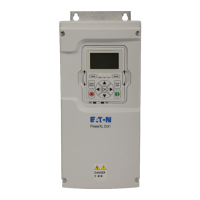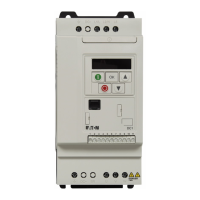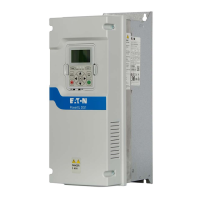97
PROFIBUS-DP external communication cards
POWERXL DG1 SERIES VFD MN040010EN—September 2016 www.eaton.com
DPV1 acyclic communication
Base model parameter access, whose structure is
defined in the PROFIdrive profile 4.1, is always used
for communicating the writing/reading parameters for
PROFIdrive drives such as PowerXL.
Under this arrangement, parameters access always consists
of two elements. Under this arrangement, parameter
access always consists of two elements.
Write request (“Write data set “)
Read request (“Read data set”)
Write request or Request can be send via DPV1 master
class 1 or master class 2.
The DP V1 command/response part is used for the standard
DP V1 read/Write on the Slot 0, Index47 data block.
Parameter requests and parameter responses
A parameter consists of three segments.
Request header
ID for the request and number of parameters which are
accessed. Multi-Axis and Modular drives, Addressing of
oneDO.
Parameter address
Addressing of a parameter. If parameters are accessed,
there are correspondingly many parameter addresses but
can only be accessed on a single case. The parameter
address appears only in the request, not in the response.
Parameter value. Per addressed parameter, there is a
segment for the parameter values. Depending on the
request ID, parameter values appear only either in the
request or in the reply.
Words and double words
The following telegram contents are displayed in words (a
word or 2 bytes per line). Words or double words will have
the most significant byte being transmitted first (big endian).
Table 123. Words and Double Words
Word Byte 1 Byte 2
Double Word Byte 1 Byte 2
Byte 3 Byte 4
According to the Base Model Parameter access the structure of the parameter
request and parameter response as shown in Table 124 and Table 125.
Table 124. Base mode parameter request
Block definition Byte n+1 Byte n n
Request Header Request reference Request ID 0 0
Axis-No. / DO-ID Axis-No. / DO-ID 2
1st Parameter address Attribute No. of elements 4
Parameter number (PNU)
Subindex
1st Parameter Value (s) (only for
request “Change parameter”)
Format values No. of values 4 + 6 × n
Table 125. Base model response
Block definition Byte n+1 Byte n n
Response header Request Ref. mirrored Response ID 0
Axis-No. / DO-ID mirrored No. of parameters = n 2
1st Parameter Value (s) (only after
request “Request”)
Format values or error values No.of values 4
nth Parameter values 4 +... + (Format_n × Qty_n)

